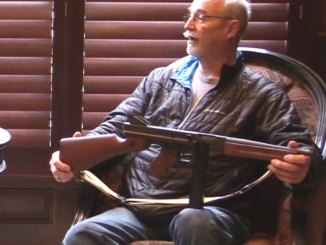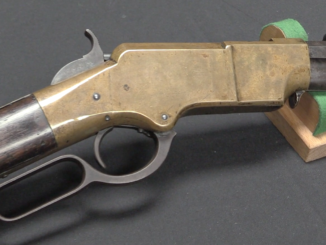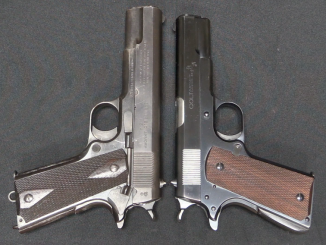Dozens of countries around the world received M1 Garand rifles from the United States in the decades after World War Two, and Denmark was one of those that not only got some rifle but went so far as to formally adopt the M1 as its post-war standard. The US and Denmark signed a mutual defense agreement in 1950 which coincided with Danish adoption of the M1 as the 7.62mm Gevaer M/50. They receiver 20,000 rifles on load, and by 1964 would purchase another 49,000 form the US (including 1,000 M1D snipers). They also purchased 20,000 rifles from Italy, who had been chosen to be the official NATO supplier of new M1s. These were made by Beretta and Breda, and have an interesting set of Danish markings on the receivers, unlike the surplus American rifles. Unlike some other countries, Denmark opted not to convert its M1s to 7.62mm NATO, and eventually replaced them in 1975 with the G3 (although is would take more than 20 years before the M1s would be sold as surplus).
Related Articles

Interview
Ken Hackathorn on the Thompson and the MP5
Today I am speaking with Ken Hackathorn about submachine guns – specifically the Thompson and the MP5. Mr Hackathorn has an extensive resume that he is quite humble about, but I will point out that […]

Lever Action Rifles
Winchester Lever Action Development: 1860 Henry
The Henry Repeating Rifle was a truly revolutionary development in firearms technology. It was not the first repeating rifle, but it was the best of a emerging class of new arms, reliable in function and […]

Prototype
Colt’s Prototype Scaled-Down Model 1910 in .38/9.8mm
With the impending success of Colt’s program to develop new .45 caliber pistol for the US military (the 1911), the company began to look for ways to exploit the work that had gone into it. […]

Was this particular weapon depicted in a monster movie? I could be wrong…
You’re probably thinking of Reptilicus (1961);
https://en.wikipedia.org/wiki/Reptilicus
Filmed in Denmark and originally released there, then released in a radically-re-edited version in the U.S. Neither version is really very good.
Even if you’re not into monster movies, and even though the movie is pretty pathetic in the writing department, it’s worth checking out for the use of Danish Army units as “extras”. Among other things, it’s one of the few times the British-made Centurion MBT has ever appeared on screen.
cheers
eon
” Among other things, it’s one of the few times the British-made Centurion MBT has ever appeared on screen.”
If Centurion is or is not MBT is arguable. Nonetheless Centurion appears also in Lebanon: The Soldier’s Journey movie.
Centurion tanks also appear in Kippur, a film about the 1973 Yom Kippur war.
I would call the late model Centurion with the 105mm gun an early MBT comparable to the M48 or T55.
The late model Israeli Centurion with 105mm gun and diesel engine also makes an appearance in, of all things, “Jesus Christ, Superstar”.
The Cruiser Tank (Heavy), A41, Centurion was designed in 1943 to supersede the previous Cruiser and Infantry tanks, to be the “Universal Tank” for British service. It was specifically designed to have armor that could resist the heaviest enemy tank gun of the time (which would have been the 8.8cm Kwk 43 on the Tiger II “King Tiger”), and mount a gun capable of defeating the frontal armor of the heaviest enemy tanks (which was the British 76.2mm 17-pounder gun).
Only the MK 1 of 1945 mounted the 17-pounder. It was deemed insufficient to deal with the likes of the then-just-rumoured T-54. So it was replaced on the MK 2 with the 84mm “20-pounder”, which was replaced in its turn on the MK 5 by the 105mm L7 gun, aka the M68 in U.S. service.
On an ironic note, many T-54/T-55 tanks in service today, as well as the Chinese made Type 59 copies thereof, have been fitted with the L7/M68-type 105mm gun, which can be spotted by the fume extractor fitted eccentrically to the bore about midway back the tube from the muzzle. (The original Russian 100mm gun has a concentric fume extractor fitted right at the muzzle.)
So, basically, the Centurion was designed to be, and was, a “Main Battle Tank” right from the beginning. It just evolved to keep pace with everybody else’s later developments, that had a hard time catching up to it.
cheers
eon
It was bad enough to be on the new Mystery Science Theater 3000 (released directly to Netflix).
Sweet memories. I was issued a M1 in 1990-1991. It had long been retiered from frontline units at that time but we used them for guarding within the Royal Guarde. It went allong with the 1864 blue wool uniform and the bear-skin hat a little better than the M75 (H&K G3). Mine was US manufacture and it was a bitch to load up with 7 shots and an empty chamber the way we carried them. But it was a much nicer shooter than the G3. They changed to using a G3 with lengthend barrel (i think) and shortened mag within about one year after I left the guarde. We claimed that it was because the new recruits could not carry the heavy M1 vertically at the shoulder the way we did it.
Thanks for the chanel Ian!
I am bit sensitive to mispronunciation of foreign names, Italian in particular since Italy is cultural cradle of all of western world and its language should be, in my opinion, respected.
In this case I got momentarily lost; names of makes seem to converge into some kind of Breeda-bereeda hybrid. I suppose that ‘Breeda’ is in fact BREDA. https://en.wikipedia.org/wiki/Breda_Meccanica_Bresciana
I am already generously overlooking such misgiving as Bereda (which may be Beretta, if I guess it right). 🙂
I was always taught to pronounce it with a long “A” sound for the “e”, as “Bray-duh”, with a slight emphasis on the first syllable. But I could be wrong, too.
cheers
eon
Eon, you are man of great knowledge when comes to firearms, but as an American you are bound with idiosyncrasy of N/A English. You make it too difficult for yourself. Believe me, from my prospective it is very messed up language. With England born people it is little easies, since they have closer to Europeans; actually they ARE part of Europe and it makes wonders (just think of those vacations to Spain and Italy they make).
I am not a linguist per se (picked only up to 4-5 foreign languages so far), but no other language twists sounds/ letters over like this one. If you lived and learned language elsewhere, you would be laughing at it. But yet (guess why…) your language dominates the world.
Guilty as charged, Milord. 🙂
Here in the U.S., in elementary school we used to be afflicted with “Phonics”, a form of English instruction based on the idea of pronouncing everything the way it was spelled. I had a 2nd grade teacher who was wont to scream “SOUND IT OUT! SOUND IT OUT!” at everybody at least once every minute or so.
The trouble is, very few words in English are pronounced even remotelylike they are spelled, according to the “Rules of English Grammar”.
English is a mishmash of Celtic, Saxon, Germanic, French, and a few other languages. Its “Catholicity” stems mainly from its users’ custom of taking “loan words” from other tongues and incorporating them. For instance, “Hypergolic”, meaning chemicals that ignite spontaneously on contact with each other, is derived from two Latin roots, but was coined by a German propellant chemist during WW2.
I have noticed that Americans, including myself, traditionally bollix up the pronunciation of French names, such as Lefaucheux; Lay-FOW-Show is the most common error. “Leh-fah-show’, with equal softness on all three syllables, is closer to it according to two of my profs who spoke fluent Parisian French, which is supposedly the equivalent of RSE in the UK. (I asked.)
I suspect that English has become the lingua franca of the world largely due to commercial aviation. Simply put, it’s easier to conduct rapid and unambiguous technical voice communication in English than in most other tongues. And aviation needs that to avoid the likely consequences of getting it wrong.
First Rule of Aviation; Historically speaking, in any meeting between a complex device made mostly of aluminum moving at over 200 knots and the ground moving at zero knots, the ground has won every time.
😉
cheers
eon
“, “Hypergolic”, meaning chemicals that ignite spontaneously on contact with each other, is derived from two Latin roots”
HYPER is actually of Greek origin.
I found Latin-Italian pronunciation rather easy. Especially I did not except that BREDA will make so much trouble, but to solve any doubts, please examine this short movie: https://www.youtube.com/watch?v=D8nBcS8X1yw
is: “(…)except(…)”
should be: “(…)expect(…)”
Just for record, I learned first time English when I served in military – (I was 21 years old) from professional teacher with UK experience. Prior to that besides of Russian I worked couple of years on perfecting German, which came handy when I was refugee. Over in EU you cannot live on one language alone. Look at Dutch – they speak commonly all 3 major languges of nations who surround them.
I know that at least some of the Danish rifles WERE converted to 7.62x51mm in Europe, even if not specifically for the Danish military, since I have one in my collection, and it seems to have came into Canada that way.
It is a BREDA made gun, or at least a BREDA receiver, (and I can’t find any “PB” marks on it). It is KFK marked with a BMR and 4 digit serial number and marked BREDA MECCANICA ROMANA ITALIA on the left side of the receiver.
I was told that the new barrel is from Austria. The barrel has the serial number of the rifle on the left side behind the front sight and is also stamped just behind that with WaII.Schu (as best i can make out, it might also be Warr.Schu), which seems to fit the “Austrian barrel” story.
The op rod is marked 7.62mm/2.
The side of the barrel does not have the usual Danish marks, but instead
59-1647 7,62mm/2 78 Then a smudged proof or acceptance mark then S-A-1-51.
I don’t have a 30-06 rifle to compare it to so I can’t tell if it is a proper 7.62 NATO barrel, or if it is a 30-06 barrel shortened and re-chambered, as was often done. There is a block behind the chamber for the shorter cartridge and the whole gun was arsenal re-finished/FTR’d. The buttplate and sling swivel and a couple of other bits show some pitting which was sandblasted off before re-parkerizing.
I’m not sure when or by who the conversion was done, if it was a factory re-furb or a private gunsmith job, but it was very well done and it is one of my favourite rifles.
The markings on your barrel is most likely “Waff.Schu”, which would mean that your M1 at some point has passed through the German firearms dealer WaffenSchumacher GmbH. As I understand it, they do a fair amount och import/export work. Your rifle may well have been rebarreled by them, perhaps for marketing purposes. If so, they will most likely have records of it (following the German propensity for “Ordnung muss sein” – there must be order).
Thanks Patrik, that fits in nicely with what I know about the gun, having come in from Europe to the dealer I bought it from.
Add Yugoslavia to a list of users – 5000 M1s were sent after 1956 Soviet intervention in Hungary. They were issued to a then nascent mechanized infantry, and stayed in use until replaced by M59/66 in 1967-68.
There was also a plan to rework those (and build more conversions) to 7.9×57, magazine fed (ZB-26/30 mag at prototypes) and shorten a barrels (IIRC to 500mm) – prototypes were made in 1957-58, it was formally accepted as M57 rifle, but normalization of relations with Soviets came with a full SKS production line, so it was shelved in favor of SKS.
I had one of these in the shop just last week. Beretta manufacture – very well made. Alas, although the rifling was very clean, the chamber was heavily rusted/pitted and the fired cases stuck in the chamber. I was able to clean up the chamber enough to allow operation 🙂
The metal and wood were in great shape and I had not seen an Italian Garand before and also wondered about the Nordic looking mark on the back. Couple of days later, Ian has the answer!
Cheers!
So while italy was exporting semiautomatic rifles to denmark the uk was sending lee enfields to the italian army
Acording to a british friend of mine the uk sent a large number of lee enfields to italy in about 1963
There are even a few boer war lee metfords
At the moment they are being imported into france for T.A.R. shooter
A good number of those Lee Enfields got converted into .22 LR trainers with Garand’s sight, others ended up with the Navy.
http://www.euroarms.net/EFD/index.htm
http://www.exordinanza.net/schede/Enfield-Terni.htm
While the converted trainers were used, all the others ended up just being stockpiled and never issued.